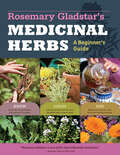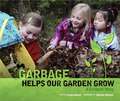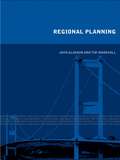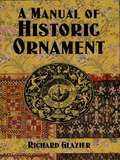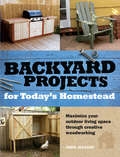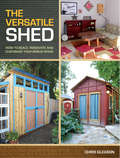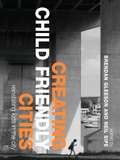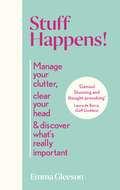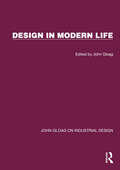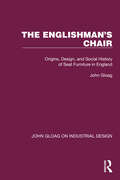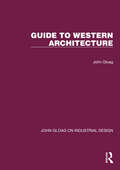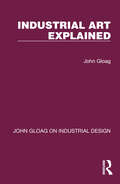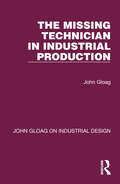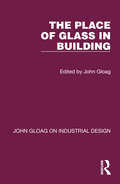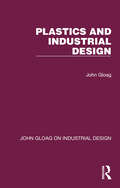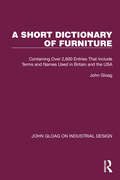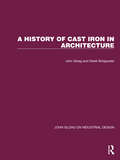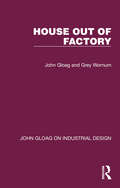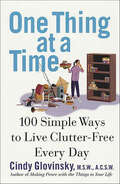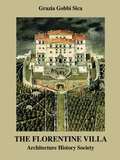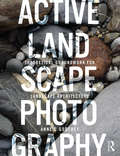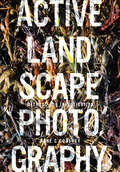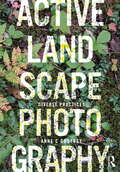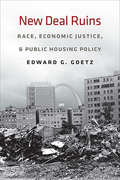- Table View
- List View
Rosemary Gladstar's Medicinal Herbs: 33 Healing Herbs to Know, Grow, and Use
by Rosemary GladstarCraft a soothing aloe lotion after an encounter with poison ivy, make a dandelion-burdock tincture to fix sluggish digestion, and brew up some lavender-lemon balm tea to ease a stressful day. In this introductory guide, Rosemary Gladstar shows you how easy it can be to make your own herbal remedies for life’s common ailments. Gladstar profiles 33 common healing plants and includes advice on growing, harvesting, preparing, and using herbs in healing tinctures, oils, and creams. Stock your medicine cabinet full of all-natural, low-cost herbal preparations.
The New York Times Guide to Home Repairs Without a Man
by Bernard GladstoneThis handy book is easy to read and easy to use. It covers the basics, suggests useful tools and gives step-by-step instructions for making repairs. It contains a clear table of contents and a useful index. I put this book to use during a holiday weekend. The toilet stopped filling and flushing and a plumber would have cost my year's salary. What I know about toilets is this: push the handy, listen for the noises which make kids laugh, all is well. If the handy does nothing it might be the thing which falls off and rusts. By following the instructions in this book, I repaired two problems without assistance. People who are blind will find that the directions and descriptions make sense without benefit of diagrams and pictures. Oh, yes. Don't be surprised if you catch your teenager or husband peeking at this book to sneak some information for their projects, too. Topics: Tools and Materials; Painting and Papering; Walls and Ceilings; Door Troubles; Window Problems; Electrical Repairs; Plumbing Repairs; Floors and Stairs; Furniture Repairs; Concrete and Masonry Repairs; Outside Repairs; Heating and Air Conditioning.
Garbage Helps Our Garden Grow: A Compost Story
by Linda GlaserWhat is that garbage doing next to the garden? It's not garbage. It's compost! Amazing things happen inside a compost bin. In go banana peels, grass clippings, and even an old jack-o'-lantern. Out comes compost. The compost goes into the garden to make the soil rich for new plants. Compost is good for the earth. Composting also helps us make less garbage. In this book, you can watch as one family makes compost for their garden and also learn how to start your very own compost bin!
Regional Planning: Concepts, Theory And Practice (Natural and Built Environment Series)
by John Glasson Tim MarshallRegional Planning provides a comprehensive introduction to the concepts and theory of regional planning in the UK. Drawing on examples from throughout the UK, it provides students and practitioners with a descriptive and analytical foundation for understanding this rapidly changing area of planning. The book includes four main sections covering: the context and history of regional planning theoretical approaches evolving practice future prospects. New questions and methods of theorizing are explored and new connections made with contemporary debates in geography, political science and planning theory. The elements of critical analysis allow both practitioners and more advanced students to reflect upon their activities in a contemporary context. Regional Planning is the essential, up-to-date text for students interested in all aspects of this increasingly influential subject.
A Manual of Historic Ornament
by Richard GlazierExceptionally comprehensive, easy-to-use guide surveys the evolution of historic ornament in architecture and the applied arts — from primitive ornaments of Oceania, Egypt, and Assyria to a Gothic doorway in Amiens, the tomb of Lorenzo de Medici, and a classic early-19th-century sofa by Thomas Hope. Over 700 black-and-white illustrations. 16 plates of photographs.
Backyard Projects for Today's Homestead
by Chris GleasonMaximize your outdoor living spaces through creative woodworking! Today's challenging economic climate has motivated many homeowners to stay in their current homes rather than upgrade, and this has sparked a major trend in what is often called the "don't move: improve!" movement. By putting a small amount of money (and some time) into sprucing-up your backyard, you can create a veritable oasis with the projects in this book. Not only can these projects improve quality of life, but building them can also be a great financial decision. Backyard Projects for Today's Homestead includes: 20 illustrated step-by-step projects that are within the skill level of beginning woodworkers Information on choosing durable materials, working with reclaimed lumber, applying finishes appropriate for outdoor wear More than just outdoor furniture - includes chicken coops, decking, gates, etc
The Versatile Shed: How To Build, Renovate and Customize Your Bonus Space
by Chris GleasonSheds aren't just for storage anymore. With a little bit of thought and work, your shed can become a guest cottage, a recording studio, a writer's getaway and even a "small" business location. With more people staying in their current homes, the opportunity to add on beyond the scope of the existing house is more appealing than ever. The Versatile Shed offers basic how-to for building your own shed structure, along with recommendations for electrical and comfort needs. Also included are ideas for working with pre-fabricated sheds, with suggestions for customization. But mostly, this book is about ideas. With dozens of ideas for interior and exterior customization that will add an extra, and versatile, space to your home.
Creating Child Friendly Cities: New Perspectives and Prospects
by Brendan Gleeson Neil SipeFirst Published in 2006. Routledge is an imprint of Taylor & Francis, an informa company.
Stuff Happens!: Manage your clutter, clear your head & discover what's really important
by Emma GleesonLife is messy, and sometimes so is your space.As a reformed hoarder turned professional declutterer, Emma Gleeson knows how easy it is to be overwhelmed by stuff. Stuff Happens! is her life-changing guide to getting a handle on your stuff and reclaiming your peace of mind. It contains a brimful of practical advice on . . .· what to keep and what to chuck (responsibly)· how to shop (especially if you struggle with a fast fashion habit)· how to organize (however tiny your space)By putting you, rather than some dream of minimalism, at the heart of the process Emma explains that it's natural to have stuff and easier than you think to stop it getting out of control. Filled with aha moments from Emma's and her clients' lives, Stuff Happens! will transform your space, headspace and your relationship with stuff FOREVER!_______________'What I LOVE about it is that it not only addresses the emotional and overwhelming part about decluttering, but also talks about doing it RESPONSIBLY' Aisling Bea'Genius! Stunning and thought-provoking' Laura de Barra, author of Gaff Goddess'So well thought out, practical and personal' Emer McLysaght'Simply brilliant. I find myself returning to it again and again' Hilary Fannin'Fab! As a total hoarder and un-organiser, Stuff Happens! is what the doctor ordered' James Kavanagh 'Not just practical, I loved how brilliantly Emma explained the psychology behind so many common problems we all have in dealing with our stuff' Daniella Moyles, author of Jump
Design in Modern Life (John Gloag On Industrial Design Ser.)
by John GloagOriginally published in 1946, this book is based on a series of broadcast talks on design. Led by an engineer, an artist and critic of architecture and industrial design, the discussions focussed on the problems that were involved by a general application of design to the environment of contemporary life. It surveys the possibilities of design in modern life and the talks have been rewritten, amplified and revised for the purposes of the book.
The Englishman's Chair: Origins, Design, and Social History of Seat Furniture in England
by John GloagOriginally published in 1964, The Englishman’s Chair is a history of English chairs, written as a continuous story from the 15th to the 20th Century and because of the revealing powers inherent in chair-making and design, it is also an unconventional footnote to English social history. The changes in taste, and fashion, the increase of skill, the introduction of new materials and the long battle between dignity and comfort are discussed, as is the impact that modern industrial designers have had on chair design.
Guide to Western Architecture
by John GloagOriginally published in 1958, A Guide to Western Architecture charts the origins of the system of architectural design that was perfected in Greece, follows its development under the Roman Empire and describes the achievements of the Byzantine architects. Passing through Romanesque to Gothic, the contributions made by Mediaeval builders to structure and design are recorded, and then the impact of the Renaissance on architecture, and its characteristic development in the different European countries. The transplanting of Renaissance ideas to the New World is covered, and finally the origins and nature of the new Western architecture occupy the last section of the book. The Appendix includes a list of the principal architects, and brief notes on their work, from the 5th century B. C. to the end of the Renaissance.
Industrial Art Explained (John Gloag On Industrial Design Ser.)
by John GloagOriginally published in 1934 this book became recognised as one of the principal standard works on industrial design and industrial architecture. The chapters explain the complete operation, character and background history of industrial art, its relation to architecture, materials, industrial production and retail distribution. It is fully illustrated with line drawings and photographs.
The Missing Technician in Industrial Production (John Gloag On Industrial Design Ser.)
by John GloagOriginally published in 1944, The Missing Technician shows how Industrial Design must begin at the very first stages of planning a product. The procedure of a design research committee is outlined – a type of practical co-ordination of the work of industrial designers and production technicians which proved highly effective. The value of materials like aluminium and plastic are emphasized, but equally the importance of glass and cast iron is stressed, especially when handled in new ways that 20th Century techniques made possible.
The Place of Glass in Building (John Gloag On Industrial Design Ser.)
by John GloagOriginally published in 1943, The Place of Glass in Building is a comprehensive and compact survey of the structural uses of glass in 20th Century architecture. It gives the facts about the physical properties, the possibilities and the limitations of the glass in common use. It also deals with the attributes of specialised and decorative glass and provides detailed descriptions of the principal types which were manufactured in the UK. Intended for architectural students it may also be of interest to architects, for it is a condensed survey of the progress that has been made in this structural and decorative material.
Plastics and Industrial Design (John Gloag On Industrial Design Ser.)
by John GloagOriginally published in 1945, Plastics and Industrial Design is a non-technical work of reference for manufacturers and designers who, after the Second World War were beginning to realize the possibilities that manufacturing with Plastics could bring. The different types of plastics and their uses is discussed, as is their impact on the design of manufactured articles. Whilst the extensive use of plastic may have fallen out of favour in recent years due to environmental concerns, this book reminds us that in their infancy they offered exciting manufacturing possibilities.
A Short Dictionary of Furniture: Containing Over 2,600 Entries That Include Terms and Names Used in Britain and the USA
by John GloagOriginally published in 1952 but enlarged and revised in 1969, this dictionary became a standard authoritative work of reference. It contains 2,612 entries and over 1,000 illustrations, reproduced from contemporary sources and from drawings by Ronald Escott, Marcelle Barton and Maureen Stafford. The work is divided into 6 sections: the first and second concern the description and design of furniture, the third contains the entries, the fourth gives a list of furniture makers in Britain and North America, section five records books and periodicals on furniture and design and the concluding section sets out in tabular form the periods with the materials used, and types of craftsmen employed from 1100 to 1950.
A History of Cast Iron in Architecture (John Gloag On Industrial Design Ser.)
by John Gloag Derek BridgwaterOriginally published in 1948, A History of Cast Iron in Architecture is a comprehensive history of the part that has been played by cast iron in architecture and the allied arts in Britain. Any history of the rise and development of the iron-founding industry becomes virtually a history of the First Industrial Revolution. Examining the use of cast iron by builders and architects from late medieval times to the middle of the 20th Century the authors have also recorded a miniature history of British Industry. The introduction throws light on the early developments of iron-founding. The main sections of the book describe the rise and expansion of the cast-iron industry and its gradually increasing significance in architecture from 1650 to 1945. There are over 500 illustrations.
House Out of Factory (John Gloag On Industrial Design Ser.)
by John Gloag Grey WornumOriginally published in 1946, when Britain was facing a post-war housing crisis, this book dealt with the issue of the factory-produced house in being part of the solution for housing people in an affordable manner and a short time-scale. The book, aimed at both lay-people and technicians discusses aspects of pre-fabricated housing such as comfort, standardisation and aesthetics. The book is illustrated with 48pp of black and white plates.
One Thing at a Time: 100 Simple Ways to Live Clutter-Free Every Day
by Cindy GlovinskySimple, effective ways to put things in their placeThose piles of papers, clothes, and other things you thought you'd successfully de-cluttered have returned, and this time they brought friends. What's the use of trying to fight the clutter? Is there a better way?This powerful and useful guide delivers solutions that work, no matter how overwhelmed you feel. The answer isn't an elaborate new system, or a solemn vow to start tomorrow. Instead, psychotherapist and organizer Cindy Glovinsky shares 100 simple strategies for tackling the problem the way it grows--one thing at a time. Here's a sampling of the tips explained in the book: *Declare a fix-it day*Purge deep storage areas first *Label it so you can read it*Get a great letter opener*Practice toy population planning *Leave it neater than you found itWritten in short takes and with a supportive tone, this is an essential, refreshing book that helps turn a hopeless struggle into a manageable part of life, one thing at a time.
The Florentine Villa: Architecture History Society (The Classical Tradition in Architecture)
by Grazia Gobbi SicaScholarly and innovative with visually stunning line drawings and photographs, this volume provides readers with a compelling record of the unbroken pattern of reciprocal use and exchange between the countryside and the walled city of Florence, from the thirteenth century up to the present day. Defying the traditional and idealized interpretation of the Florentine Villa, the author: analyzes the economic factors that powered the investment in and building of country houses and estates from the early Renaissance times onwards, as well as the ideology and the architectural and literary models that promoted the Florentine villa explores the area between Florence and Sesto in its history, morphology and representation looks at the villas existing in the area. A contribution to the protection of the important cultural heritage of the landscape in the Florentine area and of its historic buildings, villas and gardens, this study makes engaging reading, not only for scholars and students in architecture, landscape design and social history, but also for the well informed reader interested in art, architecture and gardens.
Active Landscape Photography: Theoretical Groundwork for Landscape Architecture
by Anne C GodfreyPhotographs play a hugely influential but largely unexamined role in the practice of landscape architecture and design. Through a diverse set of essays and case studies, this seminal text unpacks the complex relationship between landscape architecture and photography. It explores the influence of photographic seeing on the design process by presenting theoretical concepts from photography and cultural theory through the lens of landscape architecture practice to create a rigorous, open discussion. Beautifully illustrated in full color throughout, with over 200 images, subjects covered include the diversity of everyday photographic practices for design decision making, the perception of landscape architecture through photography, transcending the objective and subjective with photography, and deploying multiplicity in photographic representation as a means to better represent the complexity of the discipline. Rather than solving problems and providing tidy solutions to the ubiquitous relationship between photography and landscape architecture, this book aims to invigorate a wider dialogue about photography's influence on how landscapes are understood, valued and designed. Active photographic practices are presented throughout for professionals, academics, students and researchers.
Active Landscape Photography: Methods for Investigation (Active Landscape Photography)
by Anne C GodfreyHow can photography be transformed into an active process of investigation for landscape architecture and environmental design? The second book in Godfrey’s series, Active Landscape Photography, presents engaged photographic methods that turn photography into a rigorous, thoughtful endeavor for the research, planning and design of landscape places. Photography is the most ubiquitous and important form of representation in these disciplines. Yet photography is not specifically taught as a core skill within these fields. This book creates a starting point for filling this gap. Concepts and working methods from contemporary photography and critical cultural theories are contextualized into situations encountered in the daily practice of landscape architecture and environmental design. These methods can be integrated into practices in academic and professional settings or picked up and self-taught by an individual reader. Part I: Methods presents easily accessible approaches to photography creating a core set of active skills. Part II: Practices discusses working methods of specific contemporary photographers and extrapolates their practices into common extrapolates their practices into common planning and design situations. Contemporary photographers presented include Richard Misrach, Dawoud Bey, Duane Michals, Latoya Ruby Frazier, Mark Klett, Sophie Calle, Joe Deal, Robert Adams, Naima Green, Bernd and Hilla Becher, Stephen Shore, David Hockney, Amy Sherald, William Christenberry, Jeff Wall, and Sohei Nishino. Beautifully illustrated in full color with over 150 images by Godfrey, her students, and contemporary photographers, this book provides both clear guidelines for a set of diverse methods as well as a deeper discussion about the implications of making and using photography in environmental design for professionals, academics, students and researchers.
Active Landscape Photography: Diverse Practices (Active Landscape Photography)
by Anne C GodfreyDiverse Practices, the third book in the Active Landscape Photography series, presents a set of unique photographic examples for site-specific investigations of landscape places. Contributed by authors across academia, practice and photography, each chapter serves as a rigorous discussion about photographic methods for the landscape and their underlying concepts. Chapters also serve as unique case studies about specific projects, places and landscape issues. Project sites include the Miller Garden, Olana, XX Miller Prize and the Philando Castile Peace Garden. Landscape places discussed include the archeological landscapes of North Peru, watery littoral zones, the remote White Pass in Alaska, Sau Paulo and New York City’s Chinatown. Photographic image-making approaches include the use of lidar, repeat photography, collage, mapping, remote image capture, portraiture, image mining of internet sources, visual impact assessment, cameraless photography, transect walking and interviewing. These diverse practices demonstrate how photography, when utilized through a set of specific critical methods, becomes a rich process for investigating the landscape. Exploring this concept in relationship to specific contemporary sties and landscape issues reveals the intricacy and subtlety that exists when photography is used actively. Practitioners, academics, students and researchers will be inspired by the underlying concepts of these examples and come away with a better understanding about how to create their own rigorous photographic practices.
New Deal Ruins: Race, Economic Justice, and Public Housing Policy
by Edward G. GoetzPublic housing was an integral part of the New Deal, as the federal government funded public works to generate economic activity and offer material support to families made destitute by the Great Depression, and it remained a major element of urban policy in subsequent decades. As chronicled in New Deal Ruins, however, housing policy since the 1990s has turned to the demolition of public housing in favor of subsidized units in mixed-income communities and the use of tenant-based vouchers rather than direct housing subsidies. While these policies, articulated in the HOPE VI program begun in 1992, aimed to improve the social and economic conditions of urban residents, the results have been quite different. As Edward G. Goetz shows, hundreds of thousands of people have been displaced and there has been a loss of more than 250,000 permanently affordable residential units. Goetz offers a critical analysis of the nationwide effort to dismantle public housing by focusing on the impact of policy changes in three cities: Atlanta, Chicago, and New Orleans. Goetz shows how this transformation is related to pressures of gentrification and the enduring influence of race in American cities. African Americans have been disproportionately affected by this policy shift; it is the cities in which public housing is most closely identified with minorities that have been the most aggressive in removing units. Goetz convincingly refutes myths about the supposed failure of public housing. He offers an evidence-based argument for renewed investment in public housing to accompany housing choice initiatives as a model for innovative and equitable housing policy.
